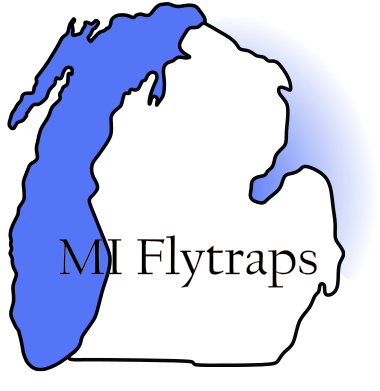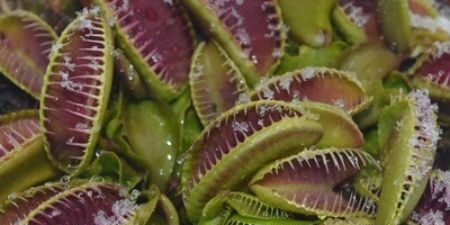FREE PLANTS | Please view our website and sign up for our newsletter. We are preparing to launch a competition where we will be gifting free plants to our subscribers! MiFlytraps.com |
|
| ITEM DESCRIPTION | The Venus flytrap shown in the pictures is the exact plant you are buying.
This item comes potted, not as bare roots, and includes complimentary shipping. It has been growing outside in our greenhouse. It is necessary to gradually acclimate it to your outdoor environment.
|
|
HOW TO ACCLIMATE | Our Venus flytraps are grown in northern Michigan. Plants should be slowly acclimated to outdoor conditions regardless of the state you reside in to prevent leaf burn in hotter regions like Texas. The sun in northern Michigan is less intense compared to southern states, making it crucial to gradually introduce your flytrap to sun exposure to avoid damage. To acclimate your Venus flytrap, start by placing it in full shade, then gradually expose it to partial sun, and eventually move it to full sun.
|
|
| | WATERING
| Water with a TDS reading of 50 PPM or less, such as rainwater, distilled water, or reverse osmosis water, is recommended for Venus flytraps. Tap water usually contains high mineral content, so it is best to avoid using it. We are near the Great Lakes, the TDS reading for the water is around 100 PPM, which is too high for the plants. You should keep your flytraps in a shallow tray of water. It is important to keep the soil damp but not overly wet to prevent root rot. During dormancy, make sure to keep the plants hydrated but avoid overwatering.
|
| HOW MUCH LIGHT
| Venus flytraps require full sun for 12-15 hours daily during the growing season, thriving best outdoors. Indoor growth is possible with full spectrum lights like Viparspectra and Mars Hydro, needing the same light duration as outdoor plants. Avoid placing flytraps on window sills as some websites suggest, as it does not provide adequate light. During dormancy, flytraps naturally receive 10-12 hours of sunlight daily, entering suspended animation in temperatures below 40°F but still preferring light.
|
| SOIL
| The Venus flytrap's natural habitat spans the Sandhills and Coastal Plains of North and South Carolina, where they flourish in mineral-free and nutrient-poor soil conditions. When potting Venus flytraps, it is recommended to use long fiber sphagnum moss (LFSM) or a mix of peat moss and perlite, avoiding vermiculite due to potential mineral content harmful to the plants. Creating your own media mix is more cost-effective than purchasing a pre-made carnivorous plant soil, with a preferred ratio of 1:1 peat moss to perlite blend or 5:3:2 peat moss to perlite to silica sand mix. While some may mix perlite with LFSM, it is not essential, as 100% LFSM can be used effectively for Venus flytrap cultivation.
|
| CONTAINERS/ POTS
| Fully mature Venus flytraps typically reach a height or width of about five inches. To accommodate their deep-rooted growth, it is recommended to plant them in containers that are at least four inches deep. This prevents the rhizome or bulb of the flytrap from sitting in water, as their roots can extend up to eight inches. Clay pots have a tendency to absorb moisture and create a breeding ground for bacteria. Glass pots can potentially overheat the flytraps in hot weather, so it's important to check if the pot feels hot to the touch. Many growers opt for tall white plastic containers to avoid this issue. Plastic containers are generally considered the best choice for growing Venus flytraps. It is not advisable to grow Venus flytraps in terrariums, domed containers, or covered habitats, as they do not do very well. They thrive when grown outdoors, where they can receive ample sunlight and fresh air.
|
| DO THEY NEED TO EAT INSECTS?
| Feeding a Venus flytrap is not necessary for its survival. They can live their entire lifespan without eating, providing them with insects during their growing season can help them grow faster. However, it is important to avoid feeding them raw meat or human food. Regular access to bugs is beneficial for Venus flytraps as the nutrients they extract from insects encourage growth and rhizome divisions. Ultimately, Venus flytraps do not need to consume bugs to stay alive or healthy, but it can aid in their development.
|
| LIFE SPAN
| The Venus Flytrap is a perennial plant that can live for more than twenty years. It reproduces asexually when the rhizome grows and forms a bulb, forming a new plant that is genetically identical to the parent plant. The traps on the Venus Flytrap have a limited lifespan and will open and close only a few times before dying off, this does not affect the overall lifespan of the plant. The traps will continue to grow and die off repeatedly.
|
| THEIR NATURAL ENVIRONMENT
| Venus flytraps are only found in the coastal regions of South and North Carolina. These plants experience cool winter weather, sometimes even receiving snowfall. |
|  | |  | MiFlytraps never disappoints! Beautiful healthy plants packaged and shipped with care and quickly. I’ve been buying plants from this grower for two seasons now and all the plants are doing well!💯 I would recommend Michigan fly traps to anyone looking for beautiful cultivars❤ | Mike M |  |
|
|  | Beautiful cultivar shipped quickly and with lots of care and consideration..Miflytraps is awesome.. Thankyou for another perfect transaction! Highly recommended website! | Dylan Shaffer |  |
|
|  | Another beautiful plant that arrived quickly, nicely packed, and in great shape! Thank you! | Melinda Bryant |  |
|
| |
Feel free to contact us anytime for any questions |
|
|
|
|



